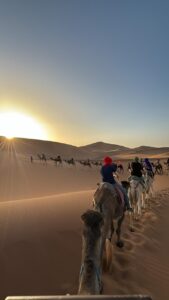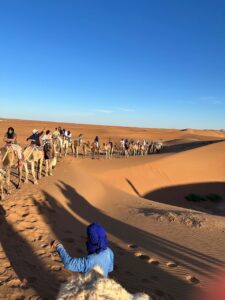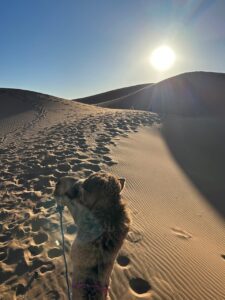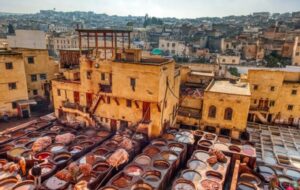From Fes To Marrakech & sahara tour via Merzouga-3 days 2 nights
Price
Duration
Max People
Min Age
Tour Type
Reviews
No reviews yet Overview
This unforgettable 3-day journey takes you across Morocco’s most diverse landscapes—from cedar forests and mountain passes to vast palm valleys, dramatic canyons, and the golden dunes of the Sahara.
Depart Fes and travel through the Middle Atlas Mountains, stopping in Ifrane and the cedar forests of Azrou, home to Barbary apes. Continue via Midelt and the palm-filled Ziz Valley to reach the desert town of Erfoud, famous for fossils, before arriving at the majestic Erg Chebbi dunes in Merzouga. Enjoy a camel ride or 4×4 transfer to your desert camp for a night under the stars.
The adventure continues through the traditional town of Rissani and the oasis of Tinghir, with time to explore the impressive Todra Gorges and the ingenious underground irrigation system known as khettarat. Travel through the Dades Valley, known for its geological formations and ancient kasbahs, and spend the night in a local hotel or kasbah.
On the final day, drive through the Valley of the Roses and the palm oasis of Skoura before reaching Ouarzazate. Visit the famous UNESCO Kasbah of Ait Benhaddou and continue across the High Atlas Mountains via the Tizi n’Tichka Pass. Arrive in Marrakech in the late afternoon after a beautiful and varied journey across southern Morocco.
DEPARTURE/RETURN LOCATION: Starts: Fez / Ends: Marrakech
DEPARTURE TIME : Please arrive by 8:00 AM
RETURN TIME : . 8:30 PM.
LOCATION : Fez, Morocco
Included/Excluded
- Tour in 4×4 vehicle
- Fuel
- Free time to explore the sites
- Hotel overnight stays (breakfast & dinner included)
- 1 night in desert camp
- Sunset Or Sunrise Camel Trek
- Driver-Guide
- Drinks
- Visites
- Lunches
Itinerary
Day 1: Fes–Ifrane-Midelt–Erfoud – Merzouga
Start our journey from Fes at 8 am, travelling past Ifrane, where the houses have sloping roofs, remarkable and unusual in Morocco. This is to cope with the yearly snowfall. Near Azrou, you can see Barbary apes in the oak and cedar forests of the Middle Atlas. From here we drive south over the Middle Atlas, passing through Timahdite. We reach Midelt, 15120M, which is called “the apple capital” of Morocco and lies at the foot of the Ayachi Mountain. The town serves as the commercial agricultural centre for the surrounding area and is also one of Morocco’s principle cities for the mining of several minerals, such as fluorite, vanadinite and quartz. This is where we will stop for lunch (not included). We continue south travelling over the Tizi-n-Tolghemt pass known as the “she-camel” pass. We descend through the Ziz Valley, which is particularly well-known for its palm trees and the length of the oasis. All along the road, there are innumerable “Ksars”, small villages of individual houses. We reach the mining town of Erachidia (e.g copper and malachite) and then Erfoud that is famous for its date festival and fossils. It is fascinating to see how these millions of fossils have been worked into artifacts and so the shops are worth a visit. There is no obligation to buy anything! You continue to Rissani and finally the famous red Erg Chebbi dunes in Merzouga. You take a camel ride either setting out from the camp or to it. There is also the possibility to take the 4×4 to the camp
Day 2: Merzouga – Rissani – Tinghir – Todra Gorges – Dades valley –
You can wake up early to enjoy the spectacle of the sunrise, when the colour of the dunes and the play of shadows are an awesome sight. Have breakfast at the camp, then, head to Tinghir and the Toudgha gorges. On the way, you pass the water channels – “khettarat” – which you can descend into to appreciate the architecture and genius behind this form of irrigation which prevents evaporation in the summer heat. The channels start at a higher gradient at one end until they finally emerge at the surface of the soil where they are fed into the fields. In the gorge and the valley, there are opportunities to walk beyond the gorge itself or by the village gardens and fields before you reach it. Later the itinerary continues to the Dades Valley. The area, which now forms the Dades Gorges, lay at the bottom of the sea millions of years ago. Great quantities of sediment were deposited around giant coral reefs, and over time this material became compacted into a variety of sedimentary rocks such as sandstone and limestone. Eventually, the movement of the earth’s crust caused the region to rise above the sea, forming the Atlas Mountains and surrounding landscape. Spend the night in a hotel or kasbah.
Day 3: Dades valley- skoura – Ouarzazate– Ait Benhaddou- Tizi N’tichka Pass- Marrakech
Have breakfast and continue the trip through the Valley of the Roses, famous for its Rose Festival in May. Pass by the kasbahs of Skoura, and where you can visit the small, interesting and intact Kasbah Amredhil, which used to be featured on the 50 dirham banknote. Pass through Ouarzazate and pay a brief visit for tea and biscuits in the Desert Majesty office, before continuing to Kasbah Ait Ben Haddou, a World Heritage site and the backdrop for many Hollywood blockbusters. It is the most famous Kasbah in Morocco. From there the road continues to Telouet, along the newly asphalted road. Telouet is set right in the midst of the mountains and was once the seat of the last Pasha of Marrakech, El Glaoui, from where the highest pass in Africa, Tizi-n-Tichka was controlled. We arrive in Marrakech in the late afternoon.



